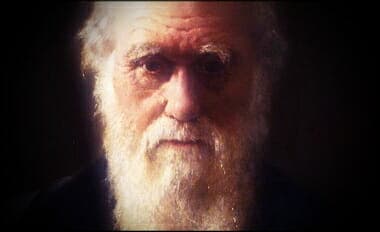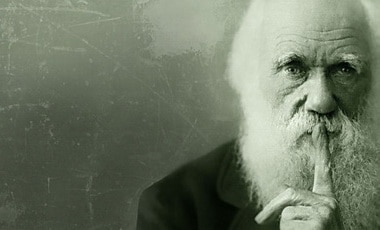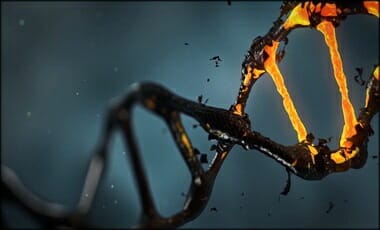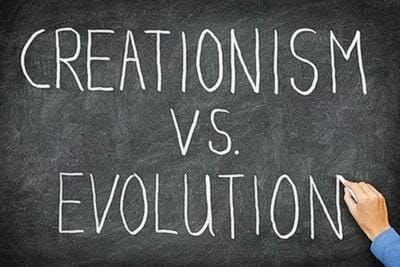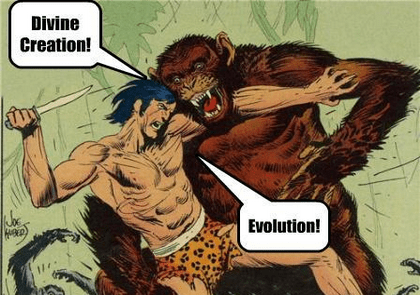(The following was originally published in July 2010 as well as July 2020… and today)
What exactly is the connection between Darwinian evolutionary theory and what is often called “social Darwinism” that emerged out of it—that includes eugenics and race based selection and preferences. Historian Richard Weikart has been with us before on the ideological roots of Naziism, and he extends his past work to connect the philosophy underlying Darwinian evolutionary theory and the race based implications coming out of it, both in Nazi Germany and the current white nationalist movement. Join Scott and Sean for this fascinating historical look at some of the ideas that came out of Darwin’s work on evolution.
Dr. Weikart’s latest book is Darwinian Racism: How Darwinism Influenced Hitler, Nazism, and White Nationalism.
Dr. Richard Weikart is Professor Emeritus of History at California State University, Stanislaus. He is also Senior Fellow for the Center for Science and Culture at the Discovery Institute. He is the author of several books including Hitler’s Religion.
Via: Think Biblically: Conversations on Faith and Culture
Darwinian Racism
with Richard Weikart
Sean McDowell, Scott Rae — June 16, 2022
Consider the following excerpt from a letter written by Charles Darwin in 1881:
“I could show fight on natural selection having done and doing more for the progress of civilization than you seem inclined to admit…. The more civilized so-called Caucasian races have beaten the Turkish hollow in the struggle for existence. Looking to the world at no very distant date, what an endless number of the lower races will have been eliminated by the higher civilized races throughout the world.”[1]
Lest this be considered merely an aberration, note that Darwin repeated this sentiment in his book The Descent of Man, he speculated, “At some future period, not very distant as measured by centuries, the civilized races of man will almost certainly exterminate and replace the savage races throughout the world. At the same time the anthropomorphous apes … will no doubt be exterminated. The break between man and his nearest allies will then be wider, for it will intervene between man in a more civilized state, as we may hope, even than the Caucasian, and some ape as low as a baboon, instead of as now between the negro or Australian and the gorilla.”[2] In addition, he subtitled his magnum opus, “The Origin of Species: The Preservation of Favored Races in the Struggle for Life.”
- “Biological arguments for racism may have been common before 1850, but they have increased by orders of magnitude following the acceptance of evolutionary theory” — Stephen Jay Gould[a]
And Darwin was not alone in his racist ideology. Thomas Huxley, who coined the term agnostic and was the man most responsible for advancing Darwinian doctrine, he argued that:
“No rational man, cognizant of the facts, believes that the average negro is the equal, still less the superior, of the white man. And if this be true, it is simply incredible that, when all his disabilities are removed, and our prognathous relative has a fair field and no favour, as well as no oppressor, he will be able to compete successfully with his bigger-brained and smaller-jawed rival, in a contest which is to be carried on by thoughts and not by bites. The highest places in the hierarchy of civilization will assuredly not be within the reach of our dusky cousins, though it is by no means necessary that they should be restricted to the lowest. But whatever the position of stable equilibrium into which the laws of social gravitation may bring the negro, all responsibility for the result will henceforward lie between Nature and him. The white man may wash his hands of it, and the Caucasian conscience be void of reproach for evermore. And this, if we look to the bottom of the matter, is the real justification for the abolition policy.”[3]
Huxley was not only militantly racist but also lectured frequently against the resurrection of Christ, in whom “[we] are all one” (Galatians 3:28). In sharp distinction to the writings of such noted evolutionists as Hrdlicka, Haeckel, and Hooton, biblical Christianity makes it crystal clear that in Christ “there is neither Jew nor Greek, slave nor free, male nor female” (Galatians 3:28). In Christianity we sing, “Red and yellow, black and white, all are precious in His sight, Jesus loves the little children of the world.” In the evolutionary hierarchy blacks are placed at the bottom, yellows and reds somewhere in the middle, and whites on top. As H. F. Osborn, director of the American Museum of National History and one of the most prominent American anthropologists of the first half of the twentieth century, put it:
“If an unbiased zoölogist were to descend upon the earth from Mars and study the races of man with the same impartiality as the races of fishes, birds and mammals, he would undoubtedly divide the existing races of man into several genera and into a very large number of species and subspecies. … This is the recognition that the genus Homo is subdivided into three absolutely distinct stocks, which in zoölogy would be given the rank of species, if not of genera, stocks popularly known as the Caucasian, the Mongolian and the Negroid. The spiritual, intellectual, moral, and physical characters which separate these three great human stocks are far more profound and ancient than those which divide the Nordic, Alpine and Mediterranean races. In my opinion these three primary stocks diverged from each other before the beginning of the Pleistocene or Ice Age. The Negroid stock is even more ancient than the Caucasian and Mongolian, as may be proved by an examination not only of the brain, of the hair, of the bodily characters, such as the teeth, the genitalia, the sense organs, but of the instincts, the intelligence. The standard of intelligence of the average adult Negro is similar to that of the eleven-year-old youth of the species Homo sapiens.”[4]
Think of the historical consequences that are the direct and logical results of the naturalist worldview. For instance, Adolf Hitler, appealed to the people of his country to have a backbone to advance the logical outworking of their worldview. Now mind you, not all naturalists are racists or killers of the less fortunate… however, this is a logical outworking of philosophical [or, metaphysical] naturalism.
“The stronger must dominate and not mate with the weaker, which would signify the sacrifice of its own higher nature. Only the born weakling can look upon this principle as cruel, and if he does so it is merely because he is of a feebler nature and narrower mind; for if such a law [natural selection] did not direct the process of evolution then the higher development of organic life would not be conceivable at all…. If Nature does not wish that weaker individuals should mate with the stronger, she wishes even less that a superior race should intermingle with an inferior one; because in such a case all her efforts, throughout hundreds of thousands of years, to establish an evolutionary higher stage of being, may thus be rendered futile.”[5]
Hitler referred to this dispensation of nature as “quite logical.” In fact, it was so logical to the Nazis that they built concentration camps to carry out their convictions about the human race as being “nothing but the product of heredity and environment” or as the Nazis liked to say, “of blood and soil.”[6]
It is significant to note that some of the Crusaders and others who used force to further their creeds in the name of God were acting in direct opposition to the teachings of Christ. [7]
The teachings of Osborn, Huxley, Hitler and others like them, however, are completely consistent with the teachings of Darwinian evolution. Indeed, social Darwinism has provided the scientific substructure for some of the most significant atrocities in human history. For evolution to succeed, it is as crucial that the unfit die as the fittest survive. Marvin Lubenow graphically portrays the ghastly consequences of such beliefs in his book Bones of Contention:
“If the unfit survived indefinitely, they would continue to ‘infect’ the fit with their less fit genes. The result is that the more fit genes would be diluted and compromised by the less fit genes, and evolution could not take place. The concept of evolution demands death. Death is thus as natural to evolution as it is foreign to biblical creation. The Bible teaches that death is a ‘foreigner,’ a condition superimposed upon humans and nature after creation. Death is an enemy, Christ has conquered it, and he will eventually destroy it. Their respective attitudes toward death reveal how many light years separate the concept of evolution from Biblical creation.”[8]
Adolph Hitler’s philosophy that Jews were subhuman and that Aryans were supermen (mirroring the beliefs Margaret Sanger, founder of Planned Parenthood) led to the extermination of about six million Jews. In the words of Sir Arthur Keith, a militant anti-Christian physical anthropologist: “The German Fuhrer, as I have consistently maintained, is an evolutionist; he has consistently sought to make the practices of Germany conform to the theory of evolution.”[9]
Karl Marx, the father of communism, saw in Darwinism the scientific and sociological support for an economic experiment that eclipsed even the carnage of Hitler’s Germany. His hatred of Christ and Christianity led to the mass murder of multiplied millions worldwide. Karl Marx so revered Darwin that his desire was to dedicate a portion of Das Kapital to him. In 1983, the dissident Soviet author Alexander Solzhenitsyn had been awarded the prestigious Templeton Prize for religious progress. In accepting the award, he gave a clear assessment of the tragedy that had been so devastating to his homeland:
“I have spent well-nigh fifty tears working on the history of our Revolution. In the process, I have read hundreds of books, collected hundreds of personal testimonies, and have already contributed eight volumes of my own towards the effort of clearing away the rubble left by that upheaval. But if I were to asked today the main cause of the ruinous Revolution that has swallowed up some sixty-million of our people, I could not put it more accurately than to repeat: ‘Men have forgotten God; that’s why all this has happened’.”
It should be noted as well that Darwinian evolution (man evolving from lower creatures) is sexist as well. Under the subheading “Difference in the Mental Powers of the Two Sexes,” Darwin attempted to persuade followers that…
“The chief distinction in the intellectual powers of the two sexes is shown by mans attaining to a higher eminence, in whatever he takes up, than can women – whether requiring deep thought, reason, or imagination, or merely the use of the senses and hands…We may also infer…[that] the average of mental power in man must be above that of women.”
In sharp contrast to the evolutionary dogma, Scripture makes it clear that all humanity is created in the image of God (Genesis 1:27; Acts 17:29); that there is essential equality between the sexes (Galatians 3:28); and that slavery is as repugnant to God as murder and adultery (1 Timothy 1:10).
Appendix
Sir Arthur Keith, Evolution and Ethics (New York: G. P. Putnam’s Sons, 1947).
p 15
“Meantime let me say that the conclusion I have come to is this: the law of Christ is incompatible with the law of evolution … as far as the law of evolution has worked hitherto. Nay, the two laws are at war with each other; the law of Christ can never prevail until the law of evolution is destroyed.”
p 28
“To see evolutionary measures and tribal morality being applied rigorously to the affairs of a great modern nation we must turn again to Germany of 1942. We see Hitler devoutly convinced that evolution produces the only real basis for a national policy.”
p 72
“Christianity makes no distinction of race or of color; it seeks to break down all racial barriers. In this respect, the hand of Christianity is against that of Nature, for are not the races of mankind the evolutionary harvest which Nature has toiled through long ages to produce? May we not say, then, that Christianity is anti-evolutionary in its aim? This may be a merit, but if so it is one which has not been openly acknowledged by Christian philosophers.”
p 150
“The law of evolution, as formulated by Darwin, provides an explanation of wars between nations, the only reasonable explanation known to us. The law was in existence, and wars were waged, for aeons of time before Darwin was born; he did not invent the law, he only made it known to his fellow men.”
Charles Darwin, Origin of Species, last paragraph.
“Thus, from the war of nature, from famine and death, the most exalted object which we are capable of conceiving, namely the production of the higher animals, directly follows.”
Footnotes
[1] Charles Darwin, Life and Letters, I, Letter to W. Graham, July 3, 1881, p. 316; cited in Darwin and the Darwinian Revolution, by Gertrude Himmelfarb (London: Chatto & Windus, 1959), p. 343.
[2] Charles Darwin, The Descent of Man, 2nd ed. (New York: A. L. Burt Co., 1874), p.178.
[a] Ontogeny and Phylogeny (Cambridge, MA: Harvard Press, 1977), 127.
[3] Thomas Huxley, Lay Sermons, Addresses and Reviews (New York: Appleton, 1871), pp 20-1.
[4] Henry Fairfield Osborn, “The Evolution of Human Races,” Natural History (January/February 1926), reprinted in Natural History, vol. 89 (April 1980), p. 129.
[5] Adolf Hitler, Mein Kampf, translator/annotator, James Murphy (New York: Hurst and Blackett, 1942), pp. 161-162.
[6] “The SS Blood and Soul,” one of four videos in a video series entitled, The Occult History of the Third Reich (St. Lauret, Quebec: Madacy Entertainment Group, 1998); Now in DVD – ISBN: 0974319465).
[7] This is a side note for those who are of the Christian faith: The Bible does not teach the horrible practices that some have committed in its name. It is true that it’s possible that religion can produce evil, and generally when we look closer at the details it produces evil because the individual people [“Christians”] are actually living in rejection of the tenets of Christianity and a rejection of the God that they are supposed to be following. So it [religion] can produce evil, but the historical fact is that outright rejection of God and institutionalizing of atheism (non-religious practices) actually does produce evil on incredible levels. We’re talking about tens of millions of people as a result of the rejection of à God. For example: the Inquisitions (2), Crusades (7), and the Salem Witch Trials killed about 40,000 persons combined (World Book Encyclopedia and Encyclopedia Americana). A blight on Christianity? Certainty. Something wrong? Dismally wrong. A tragedy? Of course. Millions and millions of people killed? No. The numbers are tragic, but pale in comparison to the statistics of what non-religious criminals have committed; the Chinese regime of Mao Tse Tung, 60 million [+] dead (1945-1965), Stalin and Khrushchev, 66 million dead (USSR 1917-1959), Khmer Rouge (Cambodia 1975-1979) and Pol Pot, one-third of their respective populations dead; etc, etc. The difference here is that these non-God movements are merely living out their worldview, the struggle for power, survival of the fittest and all that, no natural law is being violated in other words (as atheists reduce everything to natural law – materialism). However, when people have misused the Christian religion for personal gain, they are in direct violation to what Christ taught, as well as to Natural Law.
[8] Marvin L. Lubenow, Bones of Contention: A Creationist Assessment of Human Fossils (Grand Rapids, Michigan: Baker Book House, 1992), p. 47.
[9] Sir Arthur Keith, Evolution and Ethics (New York: G. P. Putnam’s Sons, 1947), p. 230. See appendix for more quotes by Keith.
PART ZOO
This is a not-too-well-known subtitle of Charles Darwin’s work. I have an introduction to this idea entitled, “Racism and Evolutionary Thought“. Stephen Jay Gould notes the affects of Darwinism on culture:
- “Biological arguments for racism may have been common before 1850, but they have increased by orders of magnitude following the acceptance of evolutionary theory”
Stephen Jay Gould, Ontogeny and Phylogeny (Cambridge, MA: Harvard Press, 1977), 127.
Human Zoos tells the shocking story of how thousands of indigenous peoples were put on public display in America in the early decades of the twentieth century.
Above video description:
Often touted as “missing links” between man and apes, these native peoples were harassed and demeaned. Their public display was arranged with the enthusiastic support of the most elite members of the scientific community, and it was promoted uncritically by American’s leading newspapers. This award-winning documentary explores the heartbreaking story of what happened, shows how African-American ministers and other people of faith tried to push back, and reveals how some people today are still drawing on Social Darwinism in order to dehumanize others. The film also explores the tragic story of eugenics in America, the effort to breed human beings based on Darwinian principles.
Human Zoos was an official selection of the African World Documentary Film Festival and has won awards for Best Editing (Oregon Documentary Film Festival), Best in Show (Cinema WorldFest Awards) and Awards of Excellence from the Impact Docs Awards and the Hollywood Independent Documentary Awards.
Be sure to check out these other videos about social Darwinism.
Here is a small snippet from a larger audio of Carl Jackson making a point about race relations. The larger audio of Mr. Jackson filling in for Dennis Prager is here
Here Is An Older Post Originally Posted In July Of 2010
SEE MORE AT ANSWERS IN GENESIS
Skull-hunters killed Aborigines and legitimized this act asserting that they were doing it for science. The skulls of the hunted natives were sold to museums after some chemical reactions that would make them look old. The skulls with bullet holes were filled in with utmost attention. According to Creation Magazine published in Australia, a group of observers that came in from South Galler were shocked when they saw that dozens of women, children and men were killed by evolutionists. Forty five skulls were chosen among the killed Aborigines, the flesh of them were set aside and boiled. The best ten were packaged to be sent to England.
 |
 |
Today, thousands of skulls of Aborigines are still in the warehouse of Smithsonian Institution. Some of these skulls belong to the corpses dug from the graves where as some others are the skulls of innocent people killed to prove evolution. 
There were also African victims of the evolutionist violence. The most famous one was the pigmy Ota Benga who was taken to the world of the white men to be displayed as a transitional form. Oto Benga was caught in 1904 by a researcher Samuel Verner in Kongo then a colony of Belgium. The native whose name meant friend in his native language, was married and had two kids. Yet he was chained, put into a cage and sent by a boat to the evolutionist scientists who within the same year displayed him in the St. Louis World Fair together with other monkey species as the closest transitional form to humankind. Two years later, he was taken to Bronx Zoo in New York where he was, this time displayed as one of the ancestors of human beings together with a few chimpanzees, a gorilla called Dinah and an orangutan called Dohung. Dr. William T. Hornaday, the director of the zoo who was also a fanatical evolutionist delivered long speeches about how he was proud of having such a precious transitional form. The guests, on the other hand, treated Ota Benga as an ordinary animal. Ota Benga could not bear the treatment he received and committed suicide. (Here is a reggae song dedicated to Oto on A BITTA WORLD by BORROW SHANGO.)
From RAE:
….The many factors motivating Verner to bring Ota to the United States were complex, but he was evidently .much influenced by the theories of Charles Darwin” a theory which, as it developed, increasingly divided humankind into human contrived races (Rymer, 1992, p. 3). Darwin also believed that the blacks were an inferior race’ (Vemer, 1908a, p. 10717). Although biological racism did not begin with Darwinism, Darwin did more than any other man to popularize it among the masses. As early as 1699, English Physician Edward Tyson studied a skeleton which he believed belonged to a pygmy, concluding that this race was apes, although it was discovered that the skeleton on which this conclusion was based was actually a chimpanzee (Bradford and Blume, 1992, p. 20).
The conclusion in Vemer’s day accepted by most scientists was that after Darwin showed “that all humans descended from apes, the suspicion remained that some races had descended farther than others … [and that] some races, namely the white ones, had left the ape far behind, while other races, pygmies especially, had hardly matured at all” (Bradford and Blume, 1992, p. 20). Many scholars agreed with Sir Harry Johnson, a pygmy scholar who stated that the pygmies were “very apelike in appearance [and] their hairy skins, the length of their arms, the strength of their thickset frames, their furtive ways, all point to these people as representing man in one of his earlier forms’ (Keane 1907, p. 99). One of the most extensive early studies of the pygmies concluded that they were “queer little freaks” and
The low state of their mental development is shown by the following facts. They have no regard for time, nor have they any records or traditions of the past; no religion is known among them, nor have they any fetish rights; they do not seek to know the future by occult means… in short, they are… the closest link with the original Darwinian anthropoid ape extant” (Burrows, 1905, pp. 172, 182)….
EXTRA
Darwin’s body snatchers
by Ken Ham, Carl Wieland and Don Batten
First published in One Blood
Chapter 9
A gruesome trade in ‘missing link’ specimens began with early evolutionary/racist ideas. But this trade really ‘took off’ with the advent of Darwinism.1
There is documented evidence that the remains of perhaps 10,000 of Australia’s Aboriginal people were shipped to British museums in a frenzied attempt to prove the widespread belief that they were the ‘missing link.’2 A major item in a leading Australian weekly, The Bulletin, revealed other shocking new facts. Some of the points covered in the article, written by Australian journalist David Monaghan, make up much of this chapter.
Evolutionists in the United States were also strongly involved in this flourishing ‘industry’ of gathering specimens of subhumans. The Smithsonian Institution in Washington holds the remains of 15,000 individuals of various races.
Along with museum curators from around the world, Monaghan says, some of the top names in British science were involved in this large-scale grave-robbing trade. These included anatomist Sir Richard Owen, anthropologist Sir Arthur Keith and Charles Darwin himself. Darwin wrote asking for Tasmanian skulls when only four of the island’s Aborigines were left alive, provided his request would not ‘upset’ their feelings. Museums were not only interested in bones, but in fresh skins as well. These would provide interesting evolutionary displays when stuffed.3
Pickled Aboriginal brains were also in demand to try to prove that they were inferior to those of whites. It was Darwin, after all, who wrote that the civilized races would inevitably wipe out such lesser-evolved ‘savage’ ones.
Good prices were being offered for such specimens. There is no doubt from written evidence that many of the ‘fresh’ specimens were obtained by simply going out and killing the Aboriginal people. The way in which the requests for specimens were announced was often a poorly disguised invitation to do just that. A deathbed memoir from Korah Wills, who became mayor of Bowen, Queensland, in 1866,4 graphically describes how he killed and dismembered a local tribesman in 1865 to provide a scientific specimen.5
Edward Ramsay, curator of the Australian Museum in Sydney for 20 years starting in 1874, was particularly heavily involved. He published a museum booklet, which appeared to include Aborigines under the designation of ‘Australian animals.’ It also gave instructions not only on how to rob graves, but also on how to plug up bullet wounds in freshly killed ‘specimens.’ Many freelance collectors worked under his guidance. Four weeks after he had requested skulls of Bungee (Russell River) blacks, a keen young science student sent him two, announcing that they, the last of their tribe, had just been shot.6 In the 1880s, Ramsay complained that laws recently passed in Queensland to stop Aborigines being slaughtered were affecting his supply.
Angel of Black Death
A German evolutionist, Amalie Dietrich (nicknamed the ‘Angel of Black Death’) came to Australia asking station (‘ranch’) owners for Aborigines to be shot for specimens, particularly skin for stuffing and mounting for her museum employers.7 Although evicted from at least one property, she shortly returned home with her specimens.
A New South Wales missionary was a horrified witness to the slaughter by mounted police of a group of dozens of Aboriginal men, women and children.8 Forty-five heads were then boiled down and the 10 best skulls were packed off for overseas.
Darwinist views about the racial inferiority of Aborigines (backed up by biased distortions of the evidence since shown to be false) drastically influenced their treatment. In 1908 an inspector from the Department of Aborigines in the West Kimberley region wrote that he was glad to have received an order to transport all half-castes away from their tribe to the mission. He said it was ‘the duty of the State’ to give these children (who, by evolutionary reasoning, were going to be intellectually superior) a ‘chance to lead a better life than their mothers.’ He wrote, ‘I would not hesitate for one moment to separate a half-caste from an Aboriginal mother, no matter how frantic her momentary grief.’9
Such separation policies continued until the 1960s.
The demand has not entirely abated. Aboriginal bones have still been sought by major institutions in quite modern times.
Men Of One Blood
And where was the Church in all this? It was much more influential back then, but it had already begun to be influenced itself by the ‘new thinking’ about origins and was not prepared to take a stand on creation issues. However, the apostle Paul’s ringing declaration, backed up by the facts of human history revealed in Genesis, was that God had ‘made all men of one blood’ (Acts 17:26). This is now reinforced by modern biology as well.
The issue of these pilfered remains is becoming politically sensitive in Australia. There is now much pressure from Aboriginal leaders and others for the remains to be returned.
Aboriginal rage at this desecration of their ancestors would also be appropriately directed at the anti-biblical thought patterns of evolution responsible for this outrage.
This phenomenon of mild-mannered museum officials, respected scientists and mayors, for example, casually going about their daily respectable lives while they were involved in monstrous acts justified by a scientific doctrine, was unparalleled in history to that point.
A similar horror reappeared in the 1930s, when the blatantly evolutionary doctrines of Nazism allowed the consciences of hundreds of doctors, scientists, psychiatrists and other officials to be seared as they set up the machinery to help nature eliminate the unfit. First, it was the genetically ‘inferior’—the mentally and physically disabled. Next, gypsies, Jews and others. The rest of the story is well known.
Today, evolutionary thinking enables ordinary, respectable professionals, otherwise dedicated to the saving of life, to justify their involvement in the slaughter of millions of unborn human beings, who, like the Aborigines of earlier Darwinian thinking, are also deemed ‘not yet fully human.’
References and notes
1) Originally published in Creation 14(2):16–18, March–May 1992.
2) Darwin’s Body Snatchers, Creation 12(3):21, June–August 1990.
3) David Monaghan, The Body-Snatchers, The Bulletin, 12 November 1991, p. 30–38. (The article states that journalist Monaghan spent 18 months researching this subject in London, culminating in a television documentary called Darwin’s Body-Ssnatchers, which was aired in Britain on 8 October 1990.)
4) According to the records of the Bowen Shire Council.
5) Monaghan, The Body-Snatchers, p. 33. In this article, Monaghan quotes two long paragraphs from Korah Will’s five-page manuscript.
6) Ibid., p. 34. Monaghan identifies the student as W.S. Day.
7) Ibid., p. 33. Monaghan is here quoting Dr Rae Sumner, a lecturer at the Queensland Institute of Technology’s School of Language and Literacy Education.
8) Ibid., p. 34. Monaghan identifies the missionary as Lancelot Threlkeld.
9) Ibid., p. 38.
